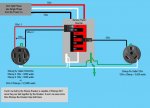Sam Casey
Member
- Location
- Washington
- Occupation
- Retired
I have a 2018 Nash 24M travel trailer. It was located on an RV pad that has a 50 amp shore Power connection. My son and his partner were living in it since winter of 2018. I had to move the trailer as a result of some work on the pad needing to be accomplished. Moved trailer about 50 feet to beside a pole building that has a 30 amp connection, which should not be a problem since trailer is 30 amp. All is well for the first couple of weeks. Then they start reporting that something is wrong. I check it out and the batteries are not charging. After a week of trying to pin down why batteries aren’t charging I decide to replace batteries. They are holding charge. So I ascertain must of been the batteries. I’ve left the trailer on the 30 amp connection for a couple of days to see if they drain like the originals did. Nope. Still good. But none of the 120 v outlets are working. I get a reading of hot/neutral when using the outlet checker device on all outlets and the gfci indicator light was red on the outlet in bathroom. Research lead me to outlets being reverse wired. My question is all was well before we moved so outlets being reversed wired wouldn’t have this problem shown up before I moved trailer? Also, what could have happened during the move to generate this problem? Due to stay at home orders in this state I cannot take to an electrician or have one come here to troubleshoot nor can I get any info from RV maker or seller and I need to get son out of spare room and back in RV. Any help or advice would be greatly appreciated.


